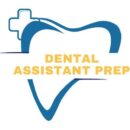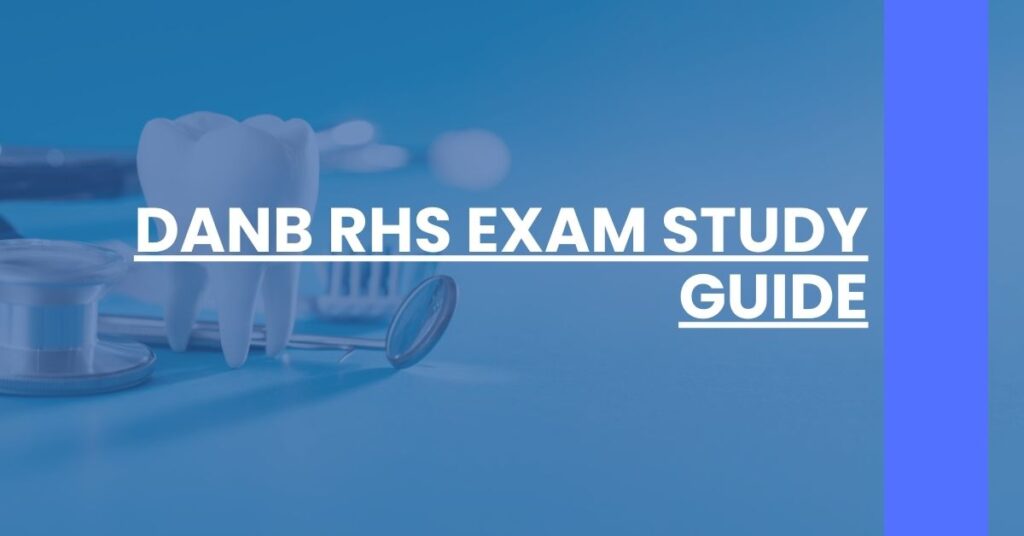Ace your certification with the DANB RHS Exam Study Guide—your roadmap to success in dental radiology.
- Comprehensive Content: Master all key concepts with in-depth material tailored to the DANB RHS exam.
- Expert Tips: Streamline your study with strategies from professionals who’ve conquered the DANB RHS exam.
- Practice Makes Perfect: Apply your knowledge with realistic practice tests designed for the DANB RHS exam.
Secure your future in dental assisting with the ultimate DANB RHS Exam Study Guide.
Understanding the DANB RHS Exam
Purpose and Importance
The Dental Assisting National Board Radiation Health and Safety (RHS) exam is a pivotal certification for dental assistants who aim to demonstrate their expertise in dental radiography. Being DANB certified can endorse a dental assistant’s dedication to professional standards and adherence to safety protocols, reinforcing their reliability in this specialized area.
Core Objectives of the Exam
The primary objectives of the RHS exam are to evaluate a candidate’s knowledge in:
- Proper Safety Procedures: Ensuring the candidate’s ability to implement safety measures for both patients and the dental team when taking X-rays.
- Radiographic Techniques and Maintenance: Assessing the candidate’s proficiency in using and maintaining radiographic equipment effectively.
- Patient Care and Management: Ensuring that the candidate can provide quality care while performing radiological procedures.
Candidates looking to prepare for the DANB RHS exam must know it’s not only a step towards being a certified dental assistant but also a calling card for higher professional standards.
Eligibility Criteria and Registration Process
Prerequisites for the Exam
To sit for the DANB RHS exam, one must first meet the eligibility criteria as outlined in the RHS Application Packet. Typically, candidates are required to have completed a dental assisting program or have a combination of education and work experience.
Steps to Registration
- Reviewing Eligibility: Confirm that you meet the necessary qualifications.
- Application Submission: Complete the application form available in the Candidate Handbook.
- Payment of Examination Fee: As part of the application process, fees are to be submitted.
- Scheduling the Exam: Once approved, schedule your exam at a testing center convenient to you.
Careful attention to the registration deadlines and necessary preparatory steps ensures no unpleasant surprises on the path to becoming certified.
Exam Structure and Content Overview
Breakdown of the Exam
The DANB RHS exam is structured to comprehensively assess the candidate’s knowledge across several domains of dental radiology. The exam format includes:
- Multiple-choice Questions: A total of 100 questions, with a significant portion being directly related to radiology best practices.
- Content of the Exam: Topics span across radiology practices, patient care, and radiation safety procedures.
- Time Allotment: Candidates are given a total of 75 minutes to complete the exam.
The RHS Exam Outline can be a highly effective blueprint for identifying the areas of focus within the study material.
Topics Covered
The RHS encompasses various sections, including but not limited to:
- Image Acquisition and Evaluation
- Radiation Safety
- Infection Control
Understanding the scope and depth of each topic will help you establish a focused study plan.
Study Materials and Resources
Recommended Reading and Practice
The foundation of any successful exam preparation lies in utilizing the right materials. Some recommended materials include:
- Official Textbooks: Books endorsed by the DANB often provide the most reliable information.
- DALE Foundation’s Online Resources: They offer a suite of interactive tools and practice tests to simulate the exam experience.
- Practice Tests: Utilize available practice tests to ensure you are familiar with the format and types of questions to expect.
Allocating time to work through recommended study materials and resources will position a candidate to excel on the exam.
Complementary Study Tools
In addition to the fundamental materials, candidates are encouraged to leverage:
- Study groups: Collaborating with peers can offer new insights and knowledge.
- Flashcards: This repetitive learning tool can be used to memorize vital concepts.
- Review Courses: Structured courses can provide a comprehensive overview and focus on crucial content areas.
The varied mix of materials and methods can cater to different learning styles, reinforcing comprehension and retentiveness.
Developing an Effective Study Plan
Crafting a Schedule
Time Management is critical. Here are some steps toward creating an effective study timeline:
- Assess your Availability: Determine how much time you can devote to studying each day or week.
- Set Realistic Goals: Plot out your study sessions by balancing them with other obligations to avoid burnout.
- Maintain Consistency: Aim to study at the same times each day or week to establish a routine.
Monitoring Progress
As you progress through the study plan, it’s important to:
- Track Learning: Maintain a journal or logbook of topics covered and areas requiring further review.
- Self-Assessment: Regularly taking practice exams to monitor improvement and adapt study strategies accordingly.
Preparing for the DANB RHS exam is a marathon, not a sprint. A well-structured study plan that takes into account personal education and experience levels can make all the difference. By strategically approaching each study session with specific objectives and using all available resources, you can approach the examination date with confidence and the assurance that you have laid the foundation for successful exam performance.
Key Topics to Focus On
When studying for the DANB RHS exam, focusing on key areas that the exam covers is essential. The depth of knowledge required can be extensive, but by pinpointing critical topics, you can allocate your study time effectively.
Radiographic Procedures and Techniques
To excel in the exam, prioritize understanding the details behind various radiographic procedures and techniques. This includes:
- Image Acquisition: Knowledge of correct procedures for capturing diagnostic images is crucial.
- Equipment Maintenance: Ensure familiarity with maintaining and troubleshooting radiographic equipment.
Radiation Safety
Safety is a paramount concern in dental radiology. Essential safety topics include:
- Radiation Physics and Biology: Understand the science behind radiation and its effects.
- Protection Protocols: Study up on safety measures for both patients and staff.
Infection Control
Infection control is another area of importance on the RHS exam. Ensure you’re comfortable with:
- Sterilization Techniques: Know the standards and procedures for equipment sterilization.
- Barrier Protocols: Be familiar with the use of barriers and personal protective equipment.
By focusing on these key topics, you set a foundation for success. Utilize the RHS Exam Outline and References provided by the DANB for a more detailed breakdown of the content areas.
Practice Tests and Question Analysis
Regularly taking practice tests should be a fundamental part of your study regimen for the RHS exam.
The Value of Practice Tests
Practice tests are crucial for several reasons:
- Familiarization: They help you get comfortable with the exam format.
- Identification of Weak Areas: They allow you to identify topics that need more attention.
- Time Management: They can help you learn to manage your time effectively during the actual test.
Analyzing Practice Questions
Don’t just take practice tests; analyze them thoroughly. After each practice test, review:
- Correct Answers: Understand why your right answers are correct.
- Wrong Answers: Dive into the reasoning behind any incorrect answers.
This practice will greatly improve your test-taking skills. Access an array of practice tests through resources like the DALE Foundation to get started.
Exam Day Tips and Strategies
When your exam day arrives, having a strategy and knowing what to expect can help reduce stress. Remember, being calm and focused is just as important as knowing the material.
What to Bring
Make sure you have all the necessary items for your RHS exam:
- Identification: A valid photo ID is essential for verification at your testing center.
- Confirmation Information: Bring any confirmation numbers or letters provided after scheduling your exam.
Arrival and Mindset
Be punctual and arrive with a clear mind:
- Punctuality: Plan to arrive at least 15 minutes early to account for any unforeseen delays.
- Mental Preparation: Practice relaxation techniques to stay calm and collected.
For detailed checklists and exam day tips, refer to guidance on the DANB website.
Reviewing Your Exam Results
After completing the DANB RHS exam, understanding how to interpret your results is key.
Exam Scoring
The DANB uses a scaled scoring system. Here’s what that means for you:
- Passing Score: A score of at least 400 is generally required to pass.
- Notification: You’ll receive your results within a few weeks after the exam, as exam results are usually sent out by mail.
Retakes and Next Steps
Should you need to retake the exam, here is what to consider:
- Retake Policy: Familiarize yourself with the retake policy, including any required waiting period before retesting.
- Continued Studying: Review the areas you struggled with to improve your score for the next attempt.
If you obtain a passing score, you can begin to explore new opportunities and advancements within your dental assisting career.
FAQs
You likely have several questions about the DANB RHS exam. Here’s a breakdown of some frequently asked questions you might have.
Study and Exam Questions
- What are the best studying methods?
- Can I reschedule my exam if needed?
Post-Exam Questions
- What are my career prospects with an RHS certification?
- Should I continue education after passing the RHS exam?
Seek answers to all your queries and learn more about what to do after you’ve passed the exam by exploring the resources available through the DALE Foundation and DANB.
Conclusion
Now that we have covered the intricate details of preparing for the DANB RHS exam, it is clear that success lies in diligent study, focused practice, and calm execution on the exam day. Remember to harness all the invaluable tips and resources shared, including the comprehensive study materials from the DALE Foundation and the detailed guidelines from the DANB. As you embark on this journey towards certification, maintain a consistent study routine, tap into the plethora of online resources, and approach your exam with confidence. With the right preparation, the DANB RHS exam is an achievable milestone on your path to a rewarding career in dental assisting. Embrace the challenge, and good luck!

